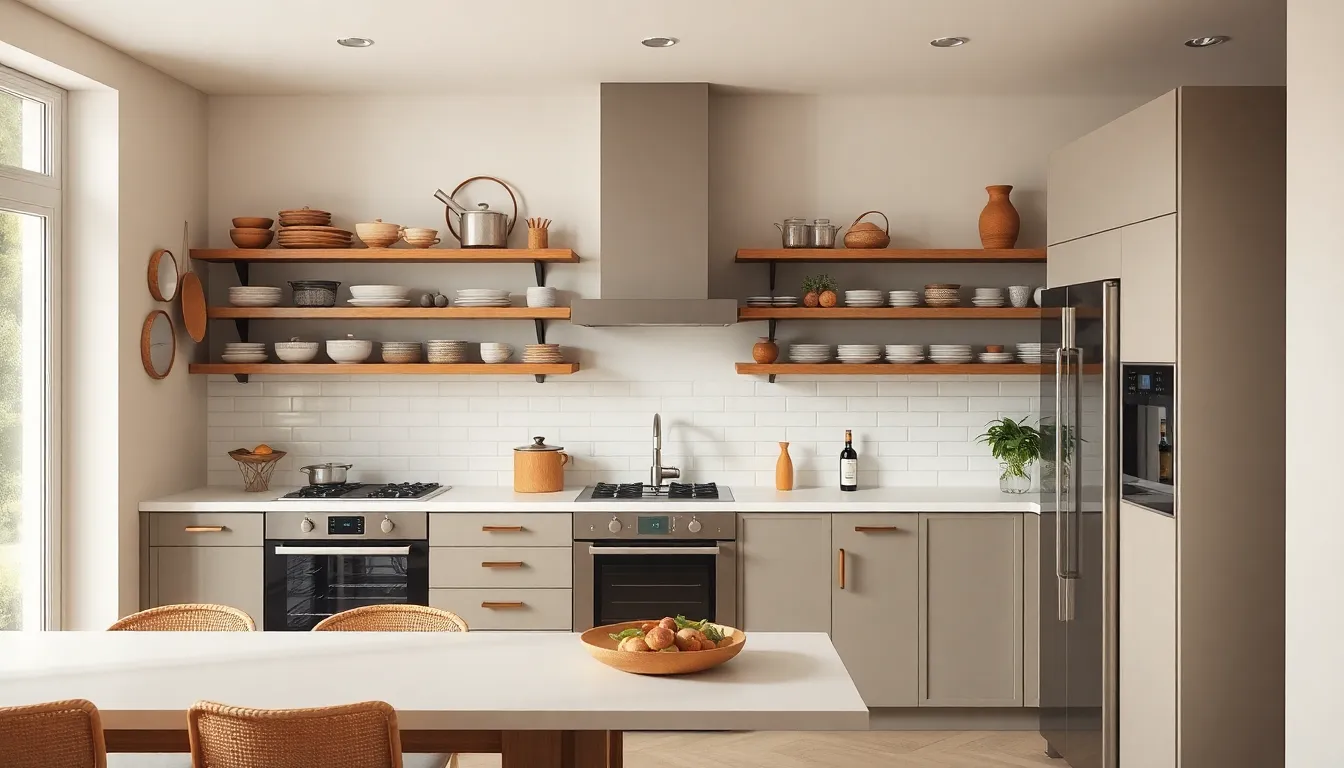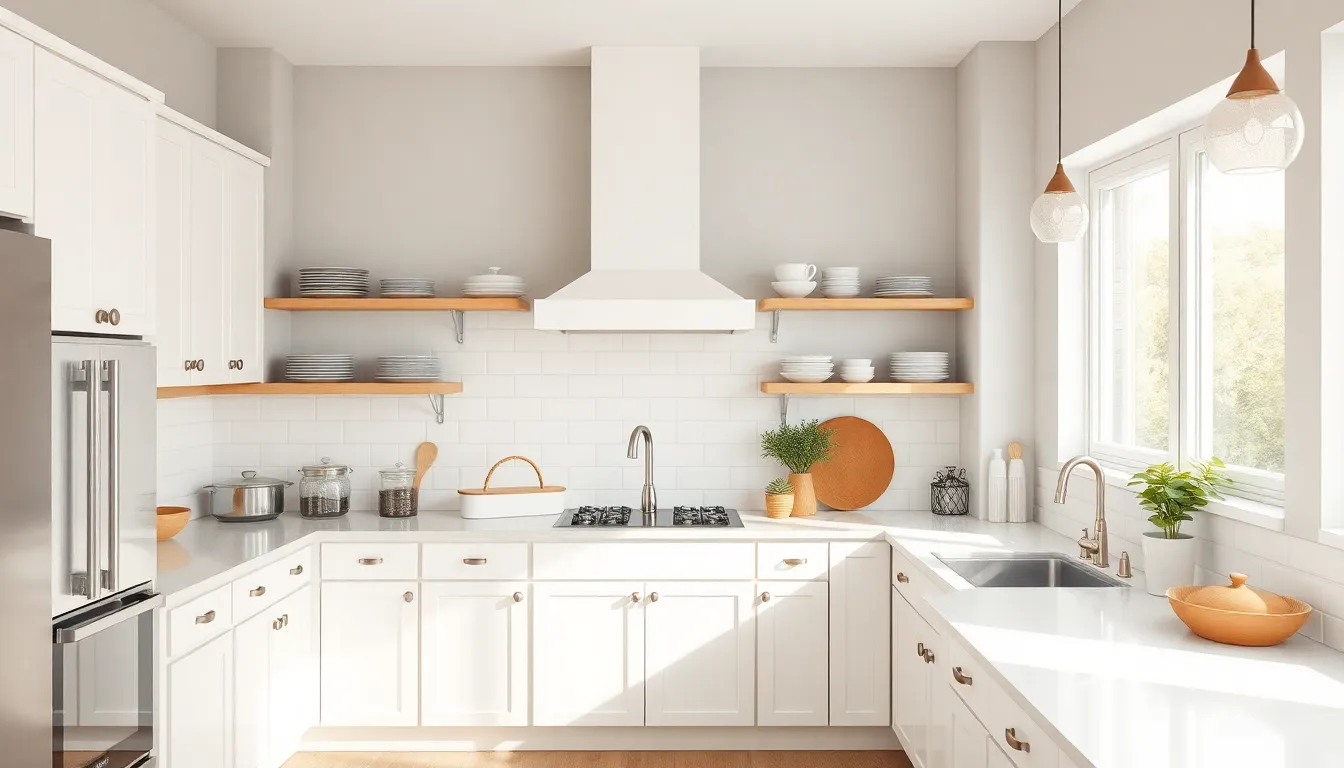In a world overflowing with clutter and chaos, the minimalist kitchen emerges as a sanctuary of simplicity and style. Picture this: a space where every utensil has its place, and the countertops are free from the usual mountain of gadgets that seem to multiply overnight. It’s not just about aesthetics; it’s a lifestyle choice that promises to streamline cooking and elevate your culinary experience.
Table of Contents
ToggleWhat Is a Minimalist Kitchen?
A minimalist kitchen embodies simplicity and functionality. It focuses on essential elements and reduces clutter, creating a serene cooking space.
Key Features
Clean lines define the aesthetic of a minimalist kitchen. Open shelving presents a practical way to display essential cookware. A limited color palette often utilizes whites, grays, and natural woods, enhancing the sense of space. Streamlined appliances contribute to an uncluttered look while maximizing efficiency. Thoughtful storage solutions optimize space, ensuring everything has its place.
Benefits of Minimalism
Minimalism promotes better organization, reducing stress while cooking. It encourages thoughtful purchasing, leading to better quality items that last longer. The design fosters an inviting atmosphere, enhancing the joy of cooking. By eliminating distractions, focus shifts back to culinary creativity. Overall, a minimalist kitchen simplifies daily routines, making cooking more enjoyable and efficient.
Designing a Minimalist Kitchen

Creating a minimalist kitchen hinges on selecting design elements that ensure both function and aesthetics. A few key considerations enhance the overall experience.
Choosing the Right Color Palette
Neutral tones, such as whites, grays, and soft earth colors, establish a calming atmosphere. These shades not only create a sense of openness but also ease the decision-making process when coordinating elements. Accentuating materials like wood or metal introduces warmth without overwhelming the space. Every color choice plays a crucial role in maintaining simplicity while contributing to visual harmony. It’s effective to use monochromatic schemes which allow variations in texture to add depth without creating clutter.
Essential Elements and Fixtures
Streamlined appliances and essential fixtures carry significant importance in a minimalist kitchen. Choosing appliances with sleek designs and compact forms contributes to an uncluttered environment. High-quality cookware and utensils should serve both functional and aesthetic purposes. Open shelving creates opportunities for displaying essential items while promoting easy access. Backsplashes can incorporate subtle textures and patterns, adding interest without distraction. Lighting choices, such as minimalist pendant fixtures or recessed lighting, improve ambiance and functionality seamlessly. Each of these elements contributes essential character while preserving the kitchen’s minimalist ethos.
Storage Solutions in a Minimalist Kitchen
Efficient storage solutions play a critical role in maintaining the clean and organized aesthetic of a minimalist kitchen.
Utilizing Vertical Space
Maximizing vertical space enhances storage while keeping the floor areas open. Wall-mounted shelves display attractive cookware and utensils, creating easy access without clutter. Hanging pot racks utilize ceiling space and showcase beautiful pots, adding a decorative touch to practicality. Additionally, tall cabinets or pantry units maximize storage capacity by reaching upward. This design choice encourages thoughtful arrangement, allowing for better item visibility and reducing the risk of overcrowding.
Smart Organization Tips
Organizing a minimalist kitchen requires strategic placement and careful selection. Drawer dividers streamline utensils and keep them in designated areas, ensuring each item has a specific spot. Clear containers facilitate visibility of pantry staples, making it easy to locate ingredients. Using pull-out shelves in lower cabinets promotes access to items without the need to crouch or rummage. Labeling food storage bins helps maintain order and promotes quick retrieval. These practices not only optimize efficiency but also simplify the cooking process in a minimalist environment.
Minimalist Kitchen Essentials
Essential tools and cookware streamline cooking processes in a minimalist kitchen. Focusing on functionality helps create an efficient space.
Must-Have Tools and Gadgets
Quality knives are crucial for any kitchen, providing precision in food preparation. A sturdy cutting board complements knife use, making chopping simple. A durable mixing bowl set accommodates various tasks, from mixing to serving. Measuring cups and spoons ensure consistency in recipes, eliminating guesswork. A reliable chef’s pan serves multiple cooking methods, including sautéing, frying, and simmering. A hand-held grater simplifies ingredient preparation, enhancing flavors in dishes. Each tool plays a role in fostering an organized and efficient kitchen environment.
Selecting Versatile Cookware
Opting for versatile cookware enhances functionality in a minimalist kitchen. A stainless-steel skillet enables quick cooking and easy cleaning. Cast iron cookware excels at heat retention and can transition from stovetop to oven. Non-stick saucepans allow for healthy cooking with less oil, promoting easy release of food. A baking sheet offers versatility, suitable for roasting vegetables or baking cookies. Selecting nesting bowls provides space-saving storage options without sacrificing utility. Each piece of cookware contributes to a streamlined cooking experience, reinforcing the minimalist philosophy.
Maintaining a Minimalist Kitchen
Maintaining a minimalist kitchen involves consistent routines and strategic decluttering. These practices ensure the space remains functional and serene.
Daily Cleaning Routines
Daily cleaning routines keep surfaces tidy and kitchens organized. Wiping down countertops eliminates crumbs and stains, making the kitchen inviting. Sweeping or vacuuming the floor daily prevents debris buildup. Dishes should be washed immediately to avoid clutter. Putting items back in their designated spots after use streamlines the space.
Incorporating these small habits into everyday routines fosters a clean atmosphere that enhances cooking experiences. Regular cleanup creates a refreshing environment conducive to culinary creativity.
Seasonal Decluttering Tips
Seasonal decluttering helps maintain simplicity in a minimalist kitchen. Every three months, assess unused items and store or donate them. Evaluating kitchen tools for functionality ensures only essentials remain. Reassessing the pantry allows for the removal of expired ingredients.
Organizing cabinets and shelves during these sessions enhances accessibility and freshness. Setting specific decluttering dates creates consistency and increases motivation. This approach not only preserves the minimalist aesthetic but also promotes a mindful culinary lifestyle.
Embracing a minimalist kitchen transforms cooking into a more enjoyable and efficient experience. By prioritizing simplicity and functionality, individuals can create a serene environment that fosters creativity and reduces stress. Thoughtful organization and smart storage solutions play a crucial role in maintaining this aesthetic, ensuring every item has its place.
Moreover, selecting quality tools and versatile cookware enhances the overall cooking process while reinforcing the minimalist philosophy. Regular maintenance routines and seasonal decluttering keep the kitchen functional and inviting. Ultimately, a minimalist kitchen not only elevates culinary skills but also promotes a mindful approach to daily cooking, making it a worthwhile investment for anyone looking to simplify their culinary space.



